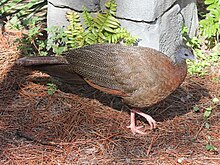Argusianus
| Great argus | |
|---|---|
 |
|
| Male | |
 |
|
| Female | |
| Scientific classification | |
| Kingdom: | Animalia |
| Phylum: | Chordata |
| Class: | Aves |
| Order: | Galliformes |
| Family: | Phasianidae |
| Genus: | Argusianus |
| Species: | A. argus |
| Binomial name | |
|
Argusianus argus (Linnaeus, 1766) |
|
| Synonyms | |
|
|
The great argus (Argusianus argus) is a species of pheasant.
The scientific name of the Great Argus was given by Carl Linnaeus in reference to the many eyes-like pattern on its wings. Argus is a hundred-eyed giant in Greek mythology. There are two subspecies recognized: Nominate argus of the Malay peninsula and Sumatra, and A. a. grayi of Borneo. William Beebe considered the two races to be distinct species, but they have since been lumped.
The double-banded argus, Argusianus bipunctatus, was long considered a potential second species. pheasant which is known only from the portion of a single primary flight feather. It was described in 1871 from this feather piece, found in a millinery shipment imported to London. Its origin was hypothesized to be from Java, Indonesia or Tioman Island of Malaysia, because of the great argus' absence from these locations. Parkes (1992) vehemently rejected the "species" validity and argued that the double-banded argus almost certainly represents a mutant form of the great argus. The IUCN, following the precautionary principle, listed this taxon as extinct until 2012. It was removed from the IUCN Red list because the IOC has removed this species from its list of valid bird taxa in 2011. While the feather is indeed quite distinct, it represents a fairly simple divergence: The entirely asymmetrically-pattern vanes are instead near-symmetrical and both bear the darker brown shaftward area with innumerable whitish speckles. The shaft is thinner than usual and the feather would probably not have been useful for flight.
...
Wikipedia

